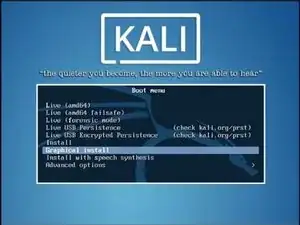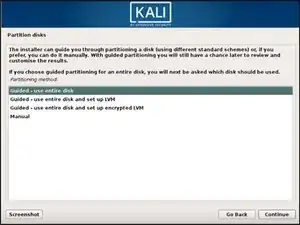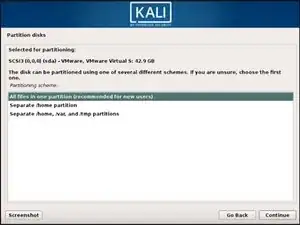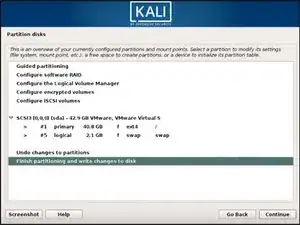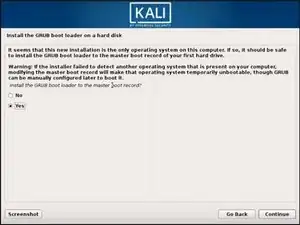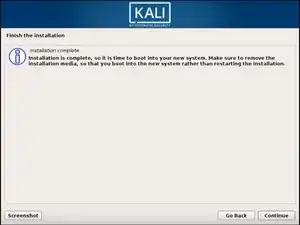Introduction
Warning: Obtaining unauthorized access to another's computer system or systems is illegal under the Computer Fraud & Abuse Act.
The following guide was made with the purpose of educating others on cyber security tools, technologies, and techniques with the intention of educating others on better protecting their own technologies and data. Please use the knowledge gained from this guide responsibly.
This guide will demonstrate how a user can install Kali Linux onto the VMware virtual machine software.
Why do people choose Kali Linux?
Kali Linux is one of the most preferred operating systems to preform cyber security and information security tasks due to the following reasons:
- Kali Linux offers more than 600 penetration testing tools from various fields of information security and forensics.
- Kali Linux is highly customizable, which allows for a great deal of versatility in features.
- Multilingual support
- Kali Linux supports a wide range of wireless devices
- Custom kernel which can be patched for injections
- Completely free and open source
Different ways to install Kali
While this guide will show how to install Kali onto a virtual machine (Offensive security does recommend using VMware Workstation for running Kali on a VM), Kali supports multiple installation options
- Bootable USB drive
- Hard disk install
- Virtualization software
- Dual boot
Installation Requirements
- Minimum of 20 GB of hard drive space is recommended
- A minimum of 4 GB of ram
- CD-DVD Drive / USB Support
-
-
Navigate to VMware Workstation Download Center
-
Based on your system requirements, click on Go to Downloads for VMware Workstation for either Windows or Linux.
-
Click Download Now, and if prompted log into your Customer Connect profile. If you don't have one you will need to create one.
-
-
-
Download Kali Linux from the official download page, and select the build the best suits your needs.
-
-
-
On the VMware Workstation homepage, click on create a new virtual machine
-
Choose the Kali Linux ISO file, and select the guest operating system.
-
Start your newly created virtual machine by selecting the Kali Linux VM, and clicking on the green Power On button
-
-
-
Once the VM is powered on, you will be prompted to select your preferred installation mode. Choose the graphical installation and continue.
-
-
-
Once your basic system configuration is set, the installer will ask you to choose a partitioning option for your virtual disk. Choose Guided - Use Entire Disk for the easiest option.
-
Select the partitioning disk and hit continue.
-
Confirm all the changes that are made to the changes to the disk on the host machine.
-
-
-
Once the necessary files are installed the installer will ask if you want to set up a Network Mirror.
-
-
-
Once you have selected your package manager option you will be asked to install the GRUB boot loader.
-
Select Yes and pick the device to write the necessary boot loader information onto the information to the virtual disk
-
-
-
Once the installer finishes installing the GRUB to the disk, click on Continue to finish the installation process.
-
Congratulations! You have installed Kali Linux, and are now ready to begin your journey into exploring Kali Linux. But, the most important thing you should take away from this guide is to remember to use this information responsibly. Obtaining unauthorized access to another's computer system or systems is illegal under the Computer Fraud & Abuse Act.
Please use the knowledge gained from this guide responsibly.
3 comments
Bonsoir a vous .
J remercie vraiment celui qui a mi les différents etapes pour pouvoir installer kali linux sans avoir de compétence avance en informatique.
J suis encore débutant mais j sens k l apprentissage pour devenir un bon hacker sera possible grâce a vous différents guides et conseils.
Merci beaucoup d avance pour tout.
Bonne soirée à toi également,
Je suis heureux que vous ayez trouvé mon guide utile. Cependant, je veux que vous gardiez à l'esprit que ce guide est conçu à des fins éducatives et ne doit être utilisé que pour tester votre propre réseau. Je ne sais pas exactement comment c'est pour les autres pays, je sais qu'aux États-Unis, le piratage n'est autorisé que dans des circonstances spécifiques. Je vous recommande vivement de rechercher des informations sur les lois sur la cybersécurité de votre pays et sur la manière dont elles sont interprétées.
J'espère que cela vous sera utile dans vos efforts
je salut vivement l'éthique de communauté pédagogique des guides d'utilisation de Kali Linux qui est pour moi une révolution de la technologie Futur ...



